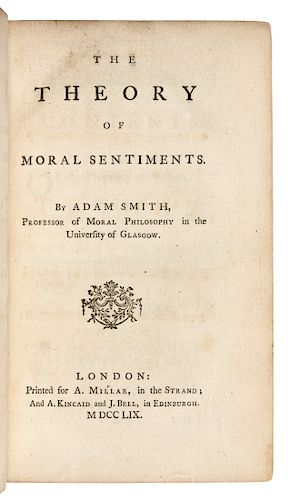SMITH, Adam (1723-1790). The Theory of Moral Sentiments. London: Printed for A. Millar, in the Strand; And A. Kincaid and J. Bell, in Edinburgh, 1759.
Lot 79
About Seller
Hindman
1338 West Lake Street
Chicago, IL 60607
United States
Recognized as the Midwest's leading fine art auctioneers, Hindman Auctioneers has built a worldwide reputation based on a full service approach to the auction business tailored to meet the individual needs of our clients. Coming from a variety of educational backgrounds, specialists bring years of e...Read more
Categories
Estimate:
$18,000 - $25,000
Absentee vs Live bid
Two ways to bid:
- Leave a max absentee bid and the platform will bid on your behalf up to your maximum bid during the live auction.
- Bid live during the auction and your bids will be submitted real-time to the auctioneer.
Bid Increments
| Price | Bid Increment |
|---|---|
| $0 | $25 |
| $500 | $50 |
| $1,000 | $100 |
| $2,000 | $250 |
| $5,000 | $500 |
| $10,000 | $1,000 |
| $20,000 | $2,500 |
| $50,000 | $5,000 |
| $100,000 | $10,000 |
About Auction
By Hindman
Nov 5, 2019
Set Reminder
2019-11-05 11:00:00
2019-11-05 11:00:00
America/New_York
Bidsquare
Bidsquare : Library of a Midwestern Collector
https://www.bidsquare.com/auctions/hindman-auctions/library-of-a-midwestern-collector-4496
Hindman Bidsquare@hindmanauctions.com
Hindman Bidsquare@hindmanauctions.com
- Lot Description
SMITH, Adam (1723-1790). The Theory of Moral Sentiments. London: Printed for A. Millar, in the Strand; And A. Kincaid and J. Bell, in Edinburgh, 1759.
8vo (199 x 122mm). With half-title and errata at end. (Occasional minor light foxing.) Contemporary calf (rebacked preserving original backstrip, later spine label); quarter morocco folding case. Provenance: George Goyder (bookplate; sold Christie’s London 26 November 1997, lot 146).
FIRST EDITION OF THE AUTHOR'S RARE FIRST BOOK, which established his reputation immediately upon publication.
Smith’s Theory of Moral Sentiments laid the foundation on which The Wealth of Nations was later to be built and proposed the theory which would be repeated in the later work: that self-seeking men are often “led by an invisible hand… without knowing it, without intending it, to advance the interest of the society.” “The fruit of his Glasgow years… The Theory of Moral Sentiments would be enough to assure the author a respected place among Scottish moral philosophers, and Smith himself ranked it above the Wealth of Nations…. Its central idea is the concept, closely related to conscience, of the impartial spectator who helps man to distinguish right from wrong. For the same purpose, Immanuel Kant invented the categorical imperative and Sigmund Freud the superego” (Niehans, 62). With Moral Sentiments and Wealth of Nations, Smith created “not merely a treatise on moral philosophy and a treatise on economics, but a complete moral and political philosophy, in which the two elements of history and theory were to be closely conjoined” (Palgrave). Published in London in April 1759 with a recorded “print run of 1,000 copies” (Sher, “Early Editions of Adam’s Smith’s Books,” 13). ESTC T141578; Goldsmiths 9537; Kress 5815; Palgrave III, pp. 412-13.
For condition inquiries please contact Gretchen Hause at gretchenhause@hindmanauctions.comCondition
- Shipping Info
-
Please refer to https://hindmanauctions.com/shipping-packing
-
- Buyer's Premium



 EUR
EUR CAD
CAD AUD
AUD GBP
GBP MXN
MXN HKD
HKD CNY
CNY MYR
MYR SEK
SEK SGD
SGD CHF
CHF THB
THB








![1667 Land Deed [Massachusetts Bay Colony / Boston] on Parchment](https://s1.img.bidsquare.com/item/m/2949/29492002.jpeg?t=1TIB0e)


